Figure 2.
Pleasure attenuated startle (PAS), acoustic startle response (ASR), and sweetened condensed milk (SCM) intake in CB1 knockout (KO) and wild-type (WT) mice. We observed a stable PAS response in WT mice; however, PAS was found to be almost absent in CB1 KO mice (a). To control for potential variances in startle habituation between the test sessions, a second cohort of KO and WT mice underwent a sham training procedure without odor-reward association and were tested according the PAS protocol. No differences could be observed between the genotypes, indicating a similar ASR reponse after repeated testing in CB1 KO and WT animals (b). The conditioned odor-cue attenuated the ASR magnitude in WT animals during the second startle session (c), whereas no such reduction could be observed in CB1 KO mice (d). Accordingly, the time course in percentage PAS was significantly lower in CB1 KO mice throughout the whole test session (e). Finally, free SCM intake was reduced in CB1 KO mice compared with WT controls (f). Data are expressed as means±SEM (p<0.05 is indicated by asterisks) (WT and CB1 KO: n=11; sham training conditions—WT and CB1 KO: n=7).

